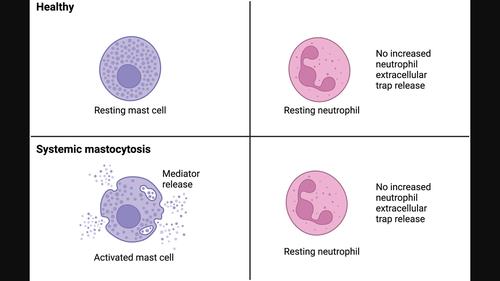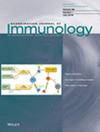No indication of aberrant neutrophil extracellular trap release in indolent or advanced systemic mastocytosis
IF 4.1
4区 医学
Q2 IMMUNOLOGY
引用次数: 0
Abstract
Abstract In disease states with chronic inflammation, there is a crosstalk between mast cells and neutrophil granulocytes in the inflamed microenvironment, which may be potentiated by tryptase. In systemic mastocytosis (SM), mast cells are constitutively active and tryptase is elevated in blood. Mast cell activation in SM leads to symptoms from various organs depending on where the active mast cells reside, for example, palpitations, flush, allergic symptoms including anaphylactic reactions, and osteoporosis. Whether neutrophil function is altered in SM is not well understood. In the current study, we assessed nucleosomal citrullinated histone H3 (H3Cit‐DNA) as a proxy for neutrophil extracellular trap release in plasma from 55 patients with indolent and advanced SM. We observed a strong trend towards a correlation between leukocyte count, eosinophil count and neutrophil count and H3Cit‐DNA levels in patients with advanced SM but not in indolent SM; however, no differences in H3Cit‐DNA levels in SM patients compared with healthy controls. H3Cit‐DNA levels did not correlate with SM disease burden, tryptase levels, history of anaphylaxis or presence of cutaneous mastocytosis; thus, there is no evidence of a general neutrophil extracellular trap release in SM. Interestingly, H3Cit‐DNA levels and leukocyte counts were elevated in a subgroup of SM patients with aberrant mast cell CD2 expression, which warrants further investigation. In conclusion, we found no evidence of global increase in neutrophil extracellular trap release in SM.

在惰性或晚期全身肥大细胞增多症中没有异常中性粒细胞胞外陷阱释放的迹象
在慢性炎症的疾病状态下,炎症微环境中肥大细胞和中性粒细胞之间存在串扰,这种串扰可能被胰蛋白酶增强。在全身性肥大细胞增多症(SM)中,肥大细胞组成性活跃,血液中胰蛋白酶升高。SM中的肥大细胞激活会导致不同器官的症状,这取决于活跃肥大细胞所在的部位,例如心悸、潮红、过敏症状(包括过敏反应)和骨质疏松症。中性粒细胞功能是否在SM中发生改变尚不清楚。在目前的研究中,我们评估了核小体瓜氨酸化组蛋白H3 (H3Cit‐DNA)作为55例惰性和晚期SM患者血浆中性粒细胞胞外陷阱释放的代理。我们观察到,在晚期SM患者中,白细胞计数、嗜酸性粒细胞计数和中性粒细胞计数与H3Cit - DNA水平有很强的相关性,而在惰性SM患者中则没有。然而,与健康对照组相比,SM患者的H3Cit - DNA水平没有差异。H3Cit‐DNA水平与SM疾病负担、胰蛋白酶水平、过敏史或皮肤肥大细胞增多症无关;因此,没有证据表明在SM中普遍存在中性粒细胞胞外陷阱释放。有趣的是,在肥大细胞CD2表达异常的SM患者亚组中,H3Cit - DNA水平和白细胞计数升高,这值得进一步研究。总之,我们没有发现中性粒细胞胞外陷阱释放在SM中整体增加的证据。
本文章由计算机程序翻译,如有差异,请以英文原文为准。
求助全文
约1分钟内获得全文
求助全文
来源期刊
CiteScore
7.70
自引率
5.40%
发文量
109
审稿时长
1 months
期刊介绍:
This peer-reviewed international journal publishes original articles and reviews on all aspects of basic, translational and clinical immunology. The journal aims to provide high quality service to authors, and high quality articles for readers.
The journal accepts for publication material from investigators all over the world, which makes a significant contribution to basic, translational and clinical immunology.

 求助内容:
求助内容: 应助结果提醒方式:
应助结果提醒方式:


